Diffusion I: Random molecular movement and influences on diffusion rate
Listen to this reading
Did you know that the process of diffusion is responsible for the way smells travel from the kitchen throughout the house? In diffusion, particles move randomly, beginning in an area of higher concentration and ending in an area of lower concentration. This principle is fundamental throughout science and is very important to how the human body and other living things function.
If you’ve ever made cookies and left the kitchen door open, you’re probably aware that the aroma spreads throughout the house. It is strongest in the kitchen, where the cookies are baking, a little less in the dining or living room, and least in the upstairs corner bedroom. And if the door is closed in the corner bedroom, the cookie scent is even weaker.
This is a delicious example of diffusion, or the movement of matter from a region of high concentration (the cookie pan in the kitchen) to a region of low concentration (the corner bedroom). This principle of diffusion is fundamental throughout science, from gas exchange in the lungs to the spread of carbon dioxide in the atmosphere to the movement of water from one side of a cell’s plasma membrane to the other. However, the concept of diffusion is rarely as simple as molecules moving from one place to another. Temperature, the size of the molecules involved, the distance molecules need to travel, the barriers they may encounter along the way, and other factors all influence the rate at which diffusion takes place.
Random walk: Molecular movement through a given space
The universe is in constant motion: from the orbiting of planets around the sun, to the movement of particles from one area to another. And while on a grand scale it may appear that there is a rationale to this movement – for example, the planets in our solar system have regular revolutions that can be predicted – in truth there is a great deal of motion that occurs randomly.
When we learn about diffusion, we often hear about the movement of particles from an area of high concentration to an area of low concentration, as if the particles themselves are somehow motivated to move in this direction. But this movement is in fact a by-product of what scientists refer to as the “random walk” of particles. Molecules do not move in straight paths from Point A to Point B. Instead, they interact with their environment, bumping into other molecules and barriers encountered along their way, as well as interacting with the medium through which they are moving.
The observation of the spontaneous, random movement of small particles was first recorded in the first century BCE. Lucretius, a Roman poet and philosopher, described the dust seen in sunbeams coming through a window (Figure 1):
You will see a multitude of tiny particles mingling in a multitude of ways... their dancing is an actual indication of underlying movements of matter that are hidden from our sight... It originates with the atoms which move of themselves [i.e., spontaneously]… So the movement mounts up from the atoms and gradually emerges to the level of our senses, so that those bodies are in motion that we see in sunbeams, moved by blows that remain invisible.
Figure 1: Dust particles "dancing" in a ray of light.
image © CC BY-SA 4.0 E.mil.milWhile Lucretius’s “dancing” particles were likely dust particles or pollen grains that are affected by air currents and other phenomenon, his description is a wonderfully accurate assessment of what goes on at the molecular level. Many scientists have explored this random molecular motion in a variety of contexts, most famously by the Scottish botanist Robert Brown in the 19th century.
In 1828, while observing pollen granules suspended in water under a microscope, Brown discovered that the motion of the granules were “neither from currents in the fluid, nor from its gradual evaporation, but belonged to the particle itself.” After suspending various organic and inorganic substances in water and seeing this same inherent, random movement, he concluded that this random walk of particles – later termed Brownian motion in his honor – was a general property of matter that is suspended in a liquid medium. However, it would take nearly a century for scientists to mathematically quantify Brownian motion and demonstrate that this random movement of molecules dictates diffusion.
Comprehension Checkpoint
What causes random molecular movement?
About the same time that Brown was making his observations, a group of scientists including the French engineer Sadi Carnot and German physicist Rudolph Clausius were establishing a whole new field of scientific study: the field of Thermodynamics (see our Thermodynamics I module for more information). Clausius’s work in particular led to the development of the kinetic theory of heat – the idea that atoms and molecules are in motion and the speed of that motion is related to a number of things, including the heat of the substance. The molecules of a solid are generally considered to be locked in place (though they vibrate); however, the molecules of a liquid or a gas are free to move around, and they do: bumping in to one another or the walls of their container like balls on a pool table.
As molecules in a liquid or gas move through space, they bump into one another and follow random paths – moving in a straight line until something blocks their way and then bouncing off of that thing. This random molecular movement is constantly occurring and can be measured, giving a molecule’s mean free path – or, the average distance a particle moves between impacts with other particles.
It is this spontaneous and random motion that leads to diffusion. For example, as the scent molecules from baking cookies move into the air, they interact with air molecules – crashing into them and changing direction. Over time, these random processes will cause the scent molecules to disperse throughout the room. Diffusion is presented as a process in which a substance moves down a concentration gradient – from an area of high concentration to an area of low concentration. However, it is important to recognize that there is no directional force at play – the scent molecules are not pushed to the edge of the room because the concentration is lower there. It is the random movement of these molecules within the roomful of moving air molecules that causes them to evenly spread out throughout the entire space – bouncing off walls, moving through doors, and eventually moving through the whole house. In this way, it appears to move along a concentration gradient – from the kitchen oven to the most distant rooms of the house.
How concentration gradients work
It may sound like a paradox – the movement of molecules are random, yet at the same time appear to occur along a gradient – but in practice, it’s actually quite logical. A simple illustration of this process can be seen using a glass of water and food coloring. When a drop of food coloring enters the water, the food coloring molecules are highly concentrated at the location where the dye molecules meet the water molecules, giving the water in that area a very dark color (Figure 2). The bottom of the glass initially has few or no food coloring molecules and so remains clear. As the food coloring molecules begin to interact with the water molecules, molecular collisions cause them to move randomly around the glass. As collisions continue, the molecules spread out, or diffuse, over space.
Figure 2: Diffusion of a purple dye in a liquid.
image ©VisionlearningEventually, the molecules spread throughout the entire glass, becoming evenly distributed and filling the space. At this point, the molecules have reached a state of equilibrium in which no net diffusion is taking place and the concentration gradient no longer exists. In this state, the molecules are still moving haphazardly and colliding with each other; we just can’t see that motion because the water and color molecules are evenly dispersed throughout the space. Once equilibrium has been reached, the probability that a molecule will move from the top to the bottom is equal to the probability a molecule will move from the bottom to the top.
Comprehension Checkpoint
Temperature and other factors influencing the rate of diffusion
We know that diffusion involves the movement of particles from one place to another; thus, the speed at which those particles move affects diffusion. Since molecular motion can be measured by the heat of an object, it follows that the hotter a substance is the faster diffusion will take place in that substance. (Click the animation below to see how temperature affects diffusion.) If you were to repeat your food coloring and water experiment comparing a glass of cold to a glass of hot water, you would see that the color disperses much more quickly in the hot water. But what other factors influence the speed, or rate, at which diffusion takes place?
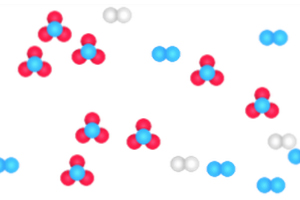
Interactive Animation: The Effect of Temperature on Diffusion
Size matters
In 1829, the Scottish physical chemist Thomas Graham first quantified diffusion behavior before the idea of atoms and molecules was widely established. Basing his observations on real-life “substances,” Graham measured the diffusion rates of gases through plaster plugs, fine tubes, and small orifices that were meant to slow down the diffusion process so that he could quantify it. One of his experiments, detailed in Figure 3, used an apparatus with the open end of a tube sitting in a beaker of water and the other end sealed with a plaster stopper containing holes large enough for gases to enter and leave the tube. Graham filled the open end of the tube with various gases (as indicated by the red tube in Figure 3), and observed the rate at which the gases effused, or escaped through the plaster plug. If the gas effused from the tube faster than the air outside of the tube moved in, the water level in the tube would rise. On the other hand, if the outside air moved through the plaster faster than the gas in the tube escaped to the outside, the water level in the tube would go down. He used the rate of change in the water level to determine the relative rate at which the different gases diffused into air.
Figure 3: Thomas Graham's experiment to measure the diffusion rates of gases.
image ©VisionlearningGraham experimented with many combinations of different gases and published his findings in an 1829 publication of the Quarterly Journal of Science, Literature, and Art titled “A Short Account of Experimental Researches on the Diffusion of Gases Through Each Other, and Their Separation by Mechanical Means.” He stated that when gases come into contact with each other, “indefinitely minute volumes” of the gases spontaneously intermix with each other until they reach equilibrium (Graham, 1829). However, he discovered that different types of gases did not mix at the same rate – rather, the rates at which two gases diffuse is inversely proportional to the square root of their densities, a relationship now known as Graham’s law. Although Graham’s original relationship used density, or mass per unit volume, the modern form of the equation uses molar mass, or the mass of one mole of a substance.
What Graham showed was that the molecular weight of a molecule directly affects the speed at which that molecule can move. Graham’s work actually helped lay the foundations of kinetic molecular theory because it recognized that at a given temperature, a heavy molecule would move more slowly than a light molecule. In other words, more kinetic energy is needed to move a large molecule at the same speed as a small molecule. You can think of it this way: A small push will get a tennis ball rolling quickly; however, it takes a much harder push to move a bowling ball at the same speed. At a given temperature, small molecules move faster, and will diffuse more quickly than large ones. View the animation below to see how atomic mass affects diffusion.
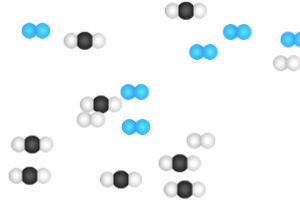
Interactive Animation: The Effect of Atomic Mass on Diffusion
Comprehension Checkpoint
Solution properties
Graham later studied the diffusion of salts into liquids and discovered that the diffusion rate in liquids is several thousand times slower than in gases. This seems relatively obvious to us today, as we know that the molecules of a gas move faster and are more spread out than molecules in a liquid. Therefore, the movement of one substance within a gas occurs more freely than in a liquid. Diffusion in liquids is proportional to temperature, as it is in gases, as well as to the viscosity of the specific liquid into which the material is diffusing. (View the animation below to compare diffusion in gases and liquids.) Diffusion, in fact, can even take place in solids. While this is a very slow process, Sir William Chandler Roberts-Austen, a British metallurgist, fused gold plates to the end of cylindrical rods made of lead. He analyzed the lead rods after a period of 31 days and actually found that gold atoms had “flowed” into the solid rods.
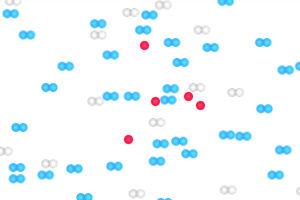
Interactive Animation: The Effect of State on Diffusion: Gases versus Liquids
Concentration and the diffusion coefficient
While we have talked extensively about diffusion and concentration gradients, it was not until the mid-1800s when a German-born physicist and physiologist named Adolf Fick built upon Graham’s work and introduced the notion of a diffusion coefficient, or diffusivity, to characterize how fast molecules diffuse.
In his 1855 publication “On Diffusion” in Annalen der Physik, Fick described an experimental setup in which he connected cylindrical and conical tubes with solid salt crystals at the bottom to an “infinitely large” reservoir filled with freshwater (Figure 4). The solid salt crystals dissolved into the water in the tubes and diffused toward the water reservoir. A stream of freshwater swept the saltwater out of the reservoir. This stream of water kept the salt concentration at the very top of the tubes (the point where the salt solution met the water reservoir) close to zero. The dissolving salt at the bottom of the tube maintained a high salt concentration in the water at that end of the tube. Because the tubes had a different shape (conical versus cylindrical), the concentration gradient in the tubes differed, setting up a system in which diffusion could be compared in relation to a concentration gradient.
Figure 4: Fick's experimental setup in which he connected cylindrical and conical tubes to a reservoir filled with freshwater. (Image from the 1903 publication, Collected Works, I. Stahel’sche Verlags-Anstalt, Würzburg: Germany.)
image ©FickFick then calculated the diffusion rate of the salt by measuring the amount of salt that passed through the top of the respective tubes (just before they met the freshwater in the reservoir) within a given time period. He discovered that the movement rate of the salt solution into the water reservoir depended on the concentration difference between the solution at the bottom of the tube and the concentration of the solution leaving the tube and entering the reservoir. In other words – the higher the concentration of salt at the top of the tube, the faster it diffused into the water reservoir. You can see how concentration affects diffusion in the animation below.
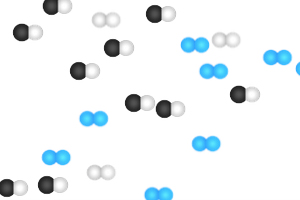
Interactive Animation: The Effect of Concentration on Diffusion
After studying the phenomenon, Fick hypothesized that the relationship between the concentration gradient and the diffusion rate was similar to what Joseph Fourier, a French mathematician and physicist, found in his study of heat conduction in 1822. Fourier had described the rate of heat transfer through a substance as proportional to the difference in temperature between two regions. Heat moves from warmer to cooler objects, and the greater the temperature difference between the two objects, the faster the heat moves. (This is why your mug of hot coffee cools off much faster outside on a cold morning than when you leave it in your heated apartment). Using Fourier’s law of thermal conduction as a model, Fick created a mathematical framework for the movement of salt into the water, proposing that the diffusion rate of a substance is proportional to the difference in concentration between the two regions. What this means for diffusion of a substance is that if the concentration of a given substance is high in relation to the substance it is diffusing into (e.g., food coloring into water), it will diffuse faster than if the concentration difference is low (e.g., food coloring into food coloring). The application of a successful principle from one branch of science to another is not uncommon, and Fick was a classic example of this process. Fick knew of Fourier’s work because he had modeled his experimental apparatus on that of Fourier. Thus it was natural for him to apply Fourier’s law to diffusion. While he had no way to know that the underlying mechanism of heat conduction and diffusion were both based on atomic collisions (in fact, some researchers at the time still doubted the existence of atoms), he had a feeling. That feeling, and the existence of atoms themselves, would be mathematically proven some 50 years later when Albert Einstein published his seminal work, Investigations on the Theory of the Brownian Movement (Einstein, 1905).
The diffusion coefficient, or diffusivity D, defined by Fick is a proportionality constant between the diffusion rate and the concentration gradient. The diffusion coefficient is defined for a specific solute-solvent pair, and the higher the value for the coefficient, the faster two substances will diffuse into one another. For example, at 25°C the diffusivity of gaseous air into gaseous water is 0.282 cm2/sec (Cussler, 1997). At the same temperature, the diffusivity of dissolved air into liquid water is 2.00 x 10-5 cm2/sec, a much lower number than that for the two gases, representing the much slower diffusion rate in liquids compared to gases. And the diffusivity of dissolved helium into liquid water at 25°C is 6.28 x 10-5 cm2/sec – higher than that of dissolved air, representing the smaller size of helium atoms compared to the nitrogen and oxygen molecules in air.
Comprehension Checkpoint
Distance molecules travel
Yet another factor that influences the rate at which diffusion occurs is the distance a molecule travels before bumping into something (referred to as a molecule’s mean free path). Imagine taking a container filled with a gas and putting it under pressure so that the molecules in the gas are squeezed together. This would slow the rate of diffusion through the gas because the molecules travel a shorter distance before colliding with something else and changing direction. (The animation below shows the effect of pressure on diffusion.)
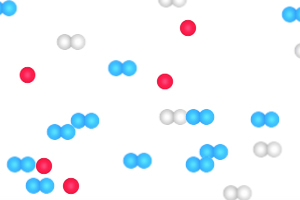
Interactive Animation: The Effect of Pressure on Diffusion
This is an important factor affecting the difference in diffusion rates in gases versus liquids versus solids; because gas particles are the most spread out of the three, molecules travel the furthest between collisions and diffusion occurs most rapidly in this state (Figure 5).
Figure 5: The three states of matter at the atomic level: gas, liquid, and solid.
image ©VisionlearningConclusion
To fully understand why we can smell the cookies baking in the kitchen from the bedroom we also have to consider another process at work here – advection. Advection involves the transfer of a material or heat due to the movement of a fluid. So, because people walk through the rooms of your house and because heat rises from your radiators, the air is constantly moving, and that movement carries and mixes the scent molecules in your house. In many situations (such as your house), the effects of advection exceed those of diffusion, but these processes work in tandem to bring you the cookie smell.
From the traveling smells of cookies to the dissolving of salt into water, diffusion is a process happening around (and within!) us every second of every day. It is a process that is critical to moving oxygen across the membranes of our lungs, moving nutrients through soil to be taken up by plants, dispersing pollutants that are released into the atmosphere, and a whole host of other events that are necessary for life to exist.